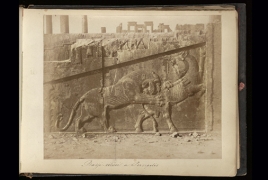"The Eye of the Shah" exhibit on view at Institute for Study of Ancient World December 19, 2015 - 16:20 AMT PanARMENIAN.Net - The Eye of the Shah: Qajar Court Photography and the Persian Past explores the fascinating world of early Iranian photography and the country it so richly depicted. With some 200 photographs—the great majority of which have never been publicly exhibited—the exhibition encompasses unprecedented, captivating images of life at the royal court in Tehran, intriguing pictures of daily life outside the court, and photographic portraits of the country’s ancient monuments and sites. Virtually all of the images were taken by royal photographers engaged by Naser al-Din Shah Qajar (r.1848–1896), the longest-reigning shah of Iran’s Qajar Dynasty (1785– 1925). They are complemented by the work of two modern-day Iranian photographers, Bahman Jalali (1944 – 2010) and Shadi Ghadirian (b. 1974), demonstrating the ongoing, enduring power of the country’s past. According to Art Daily, the Eye of the Shah is on view at the Institute for the Study of the Ancient World at New York University (ISAW) from October 22, 2015, through January 17, 2016. It has been organized by ISAW and is curated by a team comprising ISAW Exhibition Director Jennifer Y. Chi; Carmen Pérez González, research associate at Bergische Universität Wuppertal, Germany; Reza Sheikh, an independent scholar; Judith A. Lerner, research associate, ISAW; and Jennifer Miyuki Babcock, curatorial postdoctoral associate, ISAW. “The Eye of the Shah is unusual among ISAW’s exhibitions to date in looking at the past primarily through photographs rather than artifacts,” notes Dr. Chi. “In examining historic cultures and their portrayal through the then-new technique of photography, the exhibition continues ISAW’s efforts to explore both the past and the shifting ways in which we have viewed it through time.” Photography was introduced to Iran in 1842, just three years after its invention in Paris, when Naser alDin Shah’s father, Mohammed Shah Qajar, acquired two daguerreotype cameras for his court. The young crown prince soon became enamored with the medium, and eventually developed into a photographer in his own right and a visionary patron of its practice. He established photography as a major activity at court, where he built an infrastructure for it, and ensured that it was taught at the Dar al-Fonun (Polytechnic University), which he had founded. Unlike many other non-European countries that adopted photography, in Iran the medium grew primarily through the endeavors of indigenous practitioners. Except for a lucky few (including Naser al-Din Shah), these men had no formal education in the field and virtually no way of traveling to other countries to learn it. Rather, they explored the technique and artistic potential of the medium on their own, documenting Persian life and its environment and developing a portraiture practice, and leaving behind a rich and informative legacy. The Eye of the Shah contains work by photographers including relatives of the shah appointed as court photographers, the well-known Tehran-based Antoin Sevruguin, who had a thriving commercial practice, and European commercial practitioners (including Félix Nadar) who took portraits of the shah and his retinue during their journeys abroad. Photo: Getty Research Institute The creative crew of the Public TV had chosen 13-year-old Malena as a participant of this year's contest. She called on others to also suspend their accounts over the companies’ failure to tackle hate speech. Penderecki was known for his film scores, including for William Friedkin’s “The Exorcist”, Stanley Kubrick’s “The Shining”. The festival made the news public on March 19, saying that “several options are considered in order to preserve its running” Partner news |